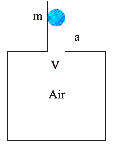In Exercises 3.13 and 3.14, we have carefully distinguished between average speed and magnitude of average velocity. No such distinction is necessary when we consider instantaneous speed and magnitude of velocity. The instantaneous speed is always equal to the magnitude of instantaneous velocity. Why?Solution in Gujrati
Because, for an arbitrarily small interval of time, the magnitude of displacement is equal to the length of the path.
Topper's Solved these Questions
- BOOK - NCERT GUJARATICHAPTER - MOTION IN A STRAIGHT LINEEXERCISE - ADDITIONAL EXERCISES5videos
MOTION IN A STRAIGHT LINE
- BOOK - NCERT GUJARATICHAPTER - MOTION IN A STRAIGHT LINEEXERCISE - ADDITIONAL EXERCISES5videos
MOTION IN A STRAIGHT LINE
- BOOK - NCERT GUJARATICHAPTER - MOTION IN A PLANEEXERCISE - EXCERCISES30videos
MOTION IN A PLANE
- BOOK - NCERT GUJARATICHAPTER - OSCILLATIONSEXERCISE - Additional Exercises6videos
OSCILLATIONS
Similar Questions
A boy standing on a stationary lift (open from above) throws a ball upwards with the maximum initial speed he can equal to 49 ms-1. How much time does the ball take to return to his hands ? If the lift starts moving up with a uniform speed of 5 ms−1 and the boy again throws the ball up with the maximum speed he can, how long goes the ball take to return to his hands ?
03:04View SolutionA boy standing on a stationary lift (open from above) throws a ball upwards with the maximum initial speed he can equal to 49 ms-1. How much time does the ball take to return to his hands ? If the lift starts moving up with a uniform speed of 5 ms−1 and the boy again throws the ball up with the maximum speed he can, how long goes the ball take to return to his hands ?
03:04View SolutionState , for each of the following physical quantities , if it is a scalar or a vector : volume , mass , speed , acceleration , density , number of moles , velocity , angular frequency , displacement , angular velocity .
03:04View SolutionAn air chamber of volume V has a neck area of cross section a into which a ball of mass m just fits and can move up and down without any friction (Fig.14.27). Show that when the ball is pressed down a little and released , it executes SHM. Obtain an expression for the time period of oscillations assuming pressure-volume variations of air to be isothermal [see Fig. 14.27].
 01:51View Solution
01:51View SolutionIn abave questions 13 and 14 , we have carefully distinguished between average speed and magnitude of average velocity. No such distainction is necessary when we considedr speed and magnitude of velocity. The instantneoud speed if alwary equal to the magnitude of nistantaneous velocity. Why ?
02:21View Solutionहमने अभ्यास 3.13 तथा 3.14 में औसत चाल व औसत वेग के परिमाण के बीच के अंतर को स्पष्ट किया है | यदि हम तात्क्षणिक चाल व वेग के परिमाण पर विचार करते हैं तो इस तरह का अंतर करना आवश्यक नहीं होता | तात्क्षणिक चाल हमेशा तात्क्षणिक वेग के बराबर होती है | क्यों ?
View Solutionहमने 13 प्रश्न 14 एवं में औसत चाल व औसत वेग के परिमाण के बीच के अंतर को स्पष्ट किया है यदि हम तात्क्षणिक चाल व वेग के परिमाण पर विचार करते है तो इस तरह का अन्तर करना आवश्यक नहीं होता है तात्क्षणिक चाल हमेशा तात्क्षणिक वेग के बराबर होती है । क्यों
View SolutionThe instantaneous speed is always equal to the magnitude of instantaneous velocity. Why?
View Solutionएकविमीय गति में तात्क्षणिक चाल, तात्क्षणिक वेग के परिमाण के बराबर होती है, क्यों ?
01:37View Solutionहमने अभ्यास 12 तथा 13 में औसत चाल व औसत वेग के परिमाण के बीच के अंतर को स्पष्ट किया है । यदि हम तात्क्षणिक चाल व वेग के परिमाण पर विचार करते हैं तो इस तरह का अंतर करना आवश्यक नहीं होता । तात्क्षणिक चाल हमेशा तात्क्षणिक वेग के बराबर होती है । क्यों ?
View Solutionहमने अभ्यास 3.13 तथा 3.14 में औसत चाल व औसत वेग के परिमाण के बीच के अंतर को स्पष्ट किया है | यदि हम तात्क्षणिक चाल व वेग के परिमाण पर विचार करते हैं तो इस तरह का अंतर करना आवश्यक नहीं होता | तात्क्षणिक चाल हमेशा तात्क्षणिक वेग के बराबर होती है | क्यों ?
06:18View Solutionहमने इस अध्याय में औसत चाल व औसत वेग के परिमाण के बीच के अन्तर को स्पष्ट किया है। यदि हम तात्क्षणिक चाल व वेग के परिमाण पर विचार करते हैं तो इस तरह का अंतर करना आवश्यक नहीं होता। तात्क्षणिक चाल हमेशा तात्क्षणिक वेग के बराबर होती है। क्यों?
02:12View SolutionWe have carefully distinguished between average speed and magnitude of average velocity. No such distinction is necessary when we consider instantaneous speed and magnitude of velocity. The instantaneous speed is always equal to the magnitude of instantaneous velocity. Why ?
05:27View SolutionWe have carefully distinguished between average speed and magnitude of average velocity. No such distinction is necessary when we consider instantaneous speed and magnitude of velocity. The instantaneous speed is always equal to the magnitude of instantaneous velocity. Why ?
View SolutionWe have carefully distinguished between average speed and magnitude of average velocity. No such distinction is necessary when we consider instantaneous speed and magnitude of velocity. The instantaneous speed is always equal to the magnitude of instantaneous velocity. Why ?
05:49View Solution

